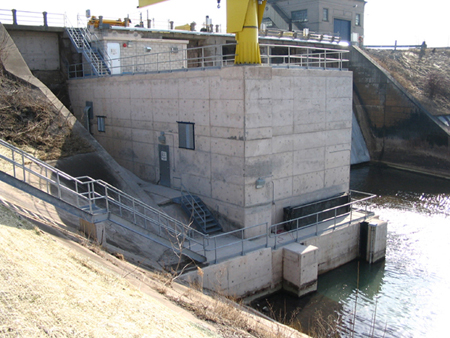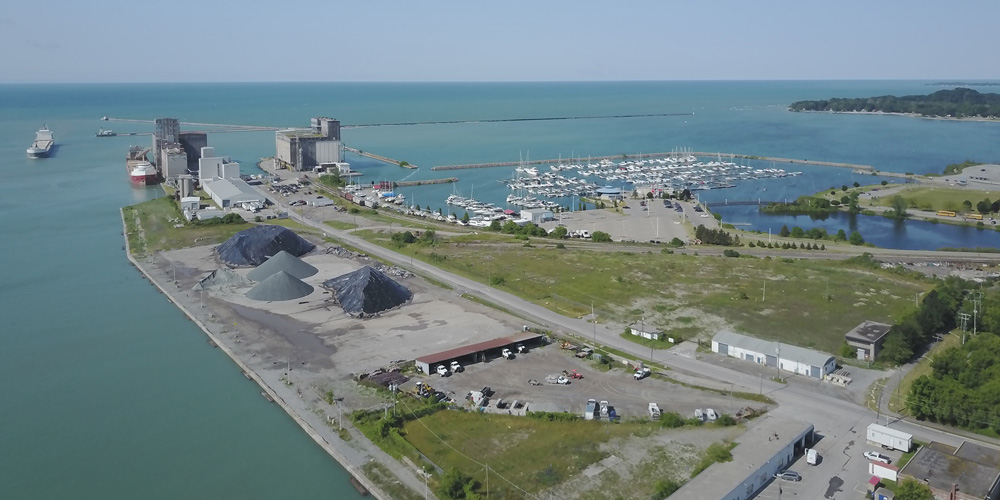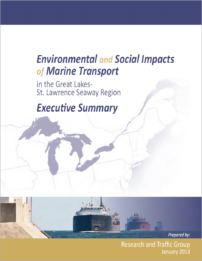Benefits of Shipping
Environmental and Social Impacts of Marine Transport
Safety Profile of the Great Lakes – St. Lawrence Seaway System
Sustainability and Aquatic Invasive Species (AIS)
Green Power from Seaway Waters
Environmental and Social Impacts of Marine Transport
For more than 200 years, the marine shipping industry has been an integral part of the Great Lakes economy.
The Great Lakes and the St. Lawrence River combine to form the longest deep-draft navigation system in the world, extending 3,700 kilometers (2,300 miles) into the North American heartland. The system includes the five Great Lakes and their connecting channels, as well as the St. Lawrence River to the Gulf of St. Lawrence. A series of locks either lift or lower vessels to overcome elevation changes. These include:
- Seven locks on the Montreal-Lake Ontario (MLO) section of the St. Lawrence Seaway, which lift/lower ships 68.8 meters (226 feet);
- Eight locks on the Welland Canal (Welland) section of the St. Lawrence Seaway, which lift/lower ships 99.4 meters (326 feet):
- One lock at Sault Ste. Marie, Michigan, which lifts/lowers ships 9.2 meters (30 feet).
Three distinct vessel-operator groups serve the waterway. These include American and Canadian domestic carriers transporting cargo between ports within the system, and international ocean-going vessel operators that operate between ports within the system and ports located overseas.
Every year, more than 160 million metric tons of raw materials, agricultural commodities and manufactured products are moved on the Great Lakes-St. Lawrence Seaway System. Dominant cargoes include iron ore for steel production, coal for power generation, limestone and cement for construction, and grain for both domestic consumption and export.
This marine highway supports the activities of more than 100 ports and commercial docks located in each of the eight Great Lakes states, and the provinces of Ontario and Quebec. It is also a crucial transportation network for commerce moving between North America and more than 59 overseas markets.
Environmental and Social Impacts of Marine Transport:
(Executive Summary of Study) / (Full Text)
Safety Profile of the Great Lakes – St. Lawrence Seaway System
This report, for the first time, measures safety performance across the entire bi-national Great Lakes-Seaway. It provides a comprehensive account of the bi-national safety framework currently in place throughout the navigation system — from regulations and the role of government, vessel construction and inspection, and mariner training — to shipowner and workplace safety programs, advanced navigation technology and emergency response capabilities.
It also provides the navigation community, transportation planners, government policy makers and the general public with a statistical assessment of the safety and environmental performance and spills record of vessels operating in these waters.
Safety Profile of the Great Lakes – St. Lawrence Seaway System:
(Executive Summary of Study)
Sustainability and Aquatic Invasive Species (AIS)
The St. Lawrence Seaway Management Corporation and the Great Lakes St. Lawrence Seaway Development Corporation recognize that, as stewards of the St. Lawrence Seaway, we operate within a shared resource. Understanding and minimizing the impact of marine transportation on the environment is critical to us. Since we hold the key to the door of the Great Lakes, we are responsible for ensuring that our efforts set the standards in this field.
The Great Lakes St. Lawrence Seaway Study, released in 2007, summarizes the problem succinctly and unequivocally: “The introduction of non-indigenous species into the Great Lakes basin and St. Lawrence River, particularly through ballast water from trans-oceanic ships, is one of the most pervasive and challenging environmental problems facing these waters.” (pg. 65)
Over the past 200 years, more than 185 invasive species have found their way into the St. Lawrence River and Great Lakes. It is important to put this invasion into context. Many vectors have played a role in this, including aquaculture, live fish markets, sport fishing, recreational boating, bait fish, pets and plants, as well as ballast water from ocean-going ships. Historically, ocean going ships are responsible for the majority of the introductions of AIS, up to two-thirds by some accounts.
A Brief History
The earliest-recorded example of an aquatic invader was the sea lamprey, which reached the Great Lakes via the Erie Canal in the 1820s. Over the last 20 years, scientists have documented about 12 new species — including the notorious zebra mussel, which has been largely responsible for making AIS a publicly recognized issue.
The zebra mussel, a fingernail-sized mollusk from the Caspian Sea, arrived in North America aboard a transatlantic freighter and was possibly flushed into Lake St. Clair along with ballast water in the late 1980s. Since then, it has spread to all of the Great Lakes as well as to rivers and numerous other lakes in Ontario, Quebec, and several states. The impact of this tiny creature has been widespread, posing challenges to a myriad of stakeholders who must now contend with its effects.
Canada brought in voluntary guidelines in 1989 requesting all ships entering the freshwaters of the St. Lawrence River and the Great Lakes to exchange their ballast. The use of ballast water exchange was based on the effectiveness of Canadian studies undertaken by Environment Canada to protect the aquaculture facilities in the Magdalen Islands.
The U.S. Coast Guard brought in mandatory regulations based on the Canadian guideline in 1993, and began inspecting ships with ballast water on board. The inspection process included boarding ships at Montreal prior to an initial transit of the system, and boarding ships between the two U.S. locks in Massena, New York, on subsequent transits. Ballast water was tested to ensure a minimum salinity of 30 parts per thousand which is considered evidence that the tanks have been adequately exchanged with saltwater, providing a reasonably harsh environment for any remaining organisms.
Beginning in 1997, the U.S. Coast Guard, Transport Canada, and the Seaway Corporations developed a joint inspection program called the “Enhanced Seaway Inspection” for foreign flag ships, which covered applicable safety and environmental equipment onboard. During the inspection by one or more of the member agencies, the ship’s ballast tanks are sampled to verify compliance.
In 2002, the U.S. and Canadian Seaway entities instituted a requirement that all foreign flag ships entering the Great Lakes Seaway System comply with the Best Management Practices of the Shipping Federation of Canada. In addition, domestic “lakers” were mandated to comply with Voluntary Management Practices, subjecting them to regular inspections of ballast tanks and regular removal of sediment.
In January 2006, a joint U.S. / Canadian Ballast Water Working Group was created to standardize the collection of commonly needed information concerning ballast water management. The group is comprised of representatives from Transport Canada Marine Safety, U.S. Coast Guard, U.S. Great Lakes St. Lawrence Seaway Development Corporation, and Canadian St. Lawrence Seaway Management Corporation. This Ballast Water Working Group initiated ballast water management ”best practices” for all vessels entering the lakes and began joint inspections of ballast water tanks.
In June of 2006, Transport Canada introduced mandatory regulations stipulating that all ships entering the Seaway from the Atlantic and destined for a Canadian port were required to exchange their ballast at least 320 kilometres (200 miles) from shore and in seas at least 200 metres deep. These rules covered, for the first time, ships with no ballast water on board, – “NOBOBs” (ships that are fully loaded with cargo and thus have little to no water in their ballast tanks). The NOBOB ships had to subject their empty tanks to salt water flushing.
Harmonizing the Rules
The introduction of these regulations created a discrepancy between the Canadian and U.S. protocols, since on the U.S. side, NOBOB testing was only a best practice.
This changed for the 2008 navigation season, with a regulatory initiative by the U.S. Seaway Corporation and the issuance of a joint Seaway regulation. For the first time, all incoming ocean ships, regardless of destination, loaded or unloaded with cargo, had to execute salt water flushing of all ballast tanks. Every oceangoing ship entering our waters is now subject to a consistent and rigorous inspection process.
Ballast Water Education
In an effort to highlight the thorough nature of the new procedures, the Canadian and U.S. Seaway Corporations hosted a Ballast Water Media Day in Montreal on May 5, 2008. The media and interested stakeholders had an opportunity to hear from academic experts that salt water flushing of ballast tanks is a highly effective means of eradicating invasive species. Demonstrations of the inspection process were held on board a Fednav, Ltd., ship, enabling journalists to witness firsthand the rigorous procedures that every incoming ocean ship is now subject to.
Video of the event:
Since March of 2008, all ballast water entering the Seaway and Great Lakes has been subject to these strict guidelines and management principles. If a vessel upon inspection is found to have non-compliant ballast water on board, it is given the option to (a) treat the non-compliant ballast water tank with a government approved treatment, (b) return to ocean waters and flush its ballast water tanks with saltwater or (c) retain the non-compliant ballast water on board for the entire duration of its transit of the Great Lakes Seaway System.
According to the strict protocol, no non-compliant ballast water is being discharged into the Seaway and Great Lakes. All ballast water is being either treated or managed. Non-compliant tanks are subject to a letter of retention, mandating that the ballast water be retained on board for the entire voyage within the Seaway and Great Lakes. Upon a vessel’s exit from the system, tanks subject to a letter of retention are re-inspected to confirm that the ballast water volume and salinity matches the volume and salinity recorded earlier upon the vessel’s entry into the system. Substantial fines apply should a vessel have violated the order to retain non-compliant ballast water onboard.
Looking Forward
Salt water flushing is currently deemed to be the most practical means of countering the introduction of new species into our waters. As we look forward, new IMO standards promise to further advance ballast water management standards. These standards hold that new vessels built in or after 2009 will need to have the means to treat ballast water and guarantee that water discharged meets a number of criteria. Under the IMO standards, existing vessels will need to undertake refits by 2014 to 2016 in order to treat ballast water and meet the same criteria.
Green Marine – An Industry First
The St. Lawrence and Great Lakes marine industry is taking action to strengthen its environmental performance. For the first time in North America, all sectors of the marine industry have united to voluntarily adopt an environmental program designed to drive a process of continuous improvement along this major maritime corridor.
The program, entitled, “Green Marine”, is being spearheaded by an alliance of the marine industry associations in Canada and the United States:
- American Great Lakes Ports Association
- Chamber of Marine Commerce
- Ontario Marine Transportation Forum
- Shipping Federation of Canada
- St. Lawrence Economic Development Council (SODES)
- St. Lawrence Shipoperators and
- United States Great Lakes Shipping Association
Both Seaway entities have been members of Green Marine community since its inception. For more information on Green Marine, please consult the www.green-marine.org web site.
Green Power from Seaway Waters
Every avenue is being explored in the Seaway’s quest to exhibit the highest standards in building a sustainable business. One example of this commitment to sustainable development is the construction of three hydroelectric power plants on the Welland Canal adjacent to Locks 1, 2 and 3 by Rankin Renewable Power Inc. Enough energy will be generated by these stations to power nearly 5,000 homes, reducing greenhouse gas emissions by 38,900 tonnes of carbon dioxide per year, the equivalent of taking 8,420 passenger cars off the road.

Credit: The St. Lawrence Seaway Management Corporation








